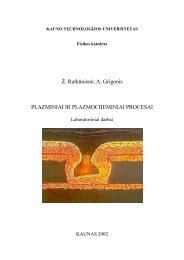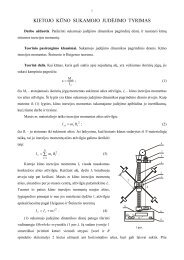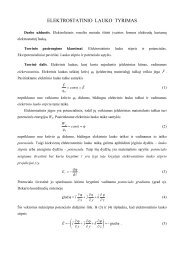PROCEEDINGS OF THE 7 INTERNATIONAL ... - Fizika
PROCEEDINGS OF THE 7 INTERNATIONAL ... - Fizika
PROCEEDINGS OF THE 7 INTERNATIONAL ... - Fizika
You also want an ePaper? Increase the reach of your titles
YUMPU automatically turns print PDFs into web optimized ePapers that Google loves.
M. Franckevicius / Medical Physics in the Baltic States 7 (2009) 34 - 38<br />
Fig.3. TEM image of silver nanoparticles in size ~2-3nm and<br />
~100nm.<br />
The steady state normalized absorption spectrum of<br />
pure LC PPI G4 dendrimer in chloroform solution<br />
presented in fig. 4, where three absorption bands at 260<br />
nm, 315 nm and 375 nm were recorded.<br />
Absorbance<br />
2.5<br />
2.0<br />
1.5<br />
1.0<br />
0.5<br />
0.0<br />
LC PPI G4<br />
250 300 350 400 450 500<br />
Wavelength, nm<br />
Fig.4. Absorption spectra of liquid crystalline PPI G4<br />
dendrimer First two absorption bands situated in lower<br />
wavelengths interval are related with dendrimer central core<br />
and interior. Therefore low intensity absorption band near<br />
375nm is related with dendrimers periphery<br />
36<br />
More accurate analysis of these LC dendrimers of<br />
various generations in different concentrations in<br />
chloroform was described in our previous work [19].<br />
Absorption band dislocated at longer wavelengths<br />
expect major advertence, because flexible liquid<br />
crystalline periphery of dendrimer could interact with<br />
silver nanoparticles. Bands maximum position of liquid<br />
crystalline dendrimers depends on generation and<br />
corresponded functional units. By increasing dendrimer<br />
size, extinction maximum position moves to longer<br />
wavelengths, while for first two bands they are almost<br />
stationar in the same wavelength position in UV region.<br />
Band shift also depends and from length of used<br />
mesogenics units on periphery. When mesogens are<br />
bigger, shift dependence from generation is wider.<br />
Therefore for these studies we have used family of<br />
dendrimers with bigger mesigenic units.<br />
Optical spectra changes corresponded with terminal<br />
units and could tell us about possible interactions<br />
between dendrimer and nanoparticle. In fig. 5a and fig.<br />
5b there are shown of silver nanoparticles plasmon<br />
resonance band in aqueous and chloroform solutions,<br />
and absorption spectra of liquid crystalline PPI<br />
dendrimer encapsulated with silver nanoparticles in fig.<br />
5c. It’s known, that the dipole absorption maximum of<br />
the silver nanoparticle rapidly shifts to longer<br />
wavelengths by increasing particle size [9] and<br />
indistinctly by the used environment. Also absorption<br />
bands markedly changes depending on environment. In<br />
our case intensity of absorption bands of these Ag<br />
nanoparticles differs for two different media. In<br />
chloroform solution, absorption maximum of silver<br />
nanoparticles decreases in about 10 times comparing<br />
with that in aqueous solution. Therefore position of<br />
bands for these different solvents was almost<br />
nonchanged. Similar results of silver nanoparticles were<br />
obtained and in distilled water, acetone and ethanol<br />
solutions by Tilaki et. all. [10].<br />
In figure 5c plotted normalized absorption spectra of<br />
liquid crystalline dendrimer interacting with silver<br />
nanoparticles. In comparison with below plotted spectra,<br />
absorption maximum is shifted to towards longer<br />
wavelength region about 20 nm. This shift of absorption<br />
band emerges from dendrimers interaction with silver<br />
nanoparticle.








